by atmara | Mar 19, 2012 | Art, Inspiration, Mandala Monday, Mandalas, Sacred Geometry
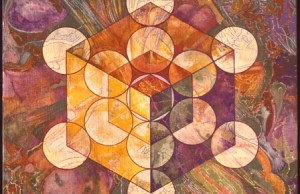
By Charles L. Gilchrist
I have been deeply involved with the study of Sacred Geometry for over thirty years. This experience has radically altered my consciousness and affected a profound psychological healing. And, as a teacher of SG I have personally witnessed the same kind of beneficial effects taking place in many of my students. This fact compels me to share my path into SG as a spiritual process. Why? Because I know that with this information, you can also step through these reliable doorways to spirit and make them your own.
I’ve always been an artist and that path eventually lead me to Sacred Geometry. My artistic talent showed itself early and by the time I was four years old I had come to believe that a special talent had been given to me for some mysterious spiritual purpose; as if it were an assignment straight from God. I was totally convinced. With an enthusiastically willing heart I took on the spiritual assignment of becoming a serious artist.
But what was an artist…. really? I was just a little boy and I had no idea how to make my inspired vision come true. So I went to my mother with the obvious question. “Mommy, what is an artist?”
At first she smiled at me and then squinted at me, guarded and thinking. I had been asking metaphysical questions of her from the time I could speak. Each question of mine would prompt another question and so on until she would completely lose her patience with me. She looked up at the ceiling, her forefinger just touching her temple as if searching her invisible mental library for the most appropriate answer. Finally her eyes brightened as she pulled out a dusty old one-liner and read it to the ceiling. “Charles,” she said, “an artist pursues truth and beauty.”
Then she softened, looked straight into my eyes and said it again, “Charles, an artist pursues truth and beauty.”
That short axiom was like a clear bell. “Oh,” is all I could say, intuitively sensing profound truth. And now after all these numerous decades, it still holds the same power.
In Wichita Kansas, the early 1940′s, my entire large family did not think making art was at all practical. After all, there was real work to do; food to grow, machines to build and a war to win. It was alright have a little artistic talent which could lead to a nice hobby but the idea of even thinking about “Fine Art” as a profession was simply unacceptable. They went on and on, trying to dissuade me. I think they actually believed that if I became a full time serious artist I would eventually go completely mad and cut off my ear like that poor insane maniac artist “what’s-his-name” Vincent Van Gogh. They were frightened…. but I wasn’t.
Regardless of their fear, I pressed on. In the early 1950′s I was a teenager living in the Chicago area. It was then I discovered the surrealist painters. I read library books with countless reproductions of the surrealist works by Max Ernst, Jean Arp, Man Ray, Joan Miro, Yves Tanguy, Rene Magritte, Alberto Giacometti. Salvador Dali, etc. I was totally fascinated by the surrealists because they were investigating their own internal dream worlds, their subconscious imagery. This kind of thinking struck a nerve in me and, at that point, I thought of myself as a “Surrealist”. I could feel the serious TRUTH of honest self-investigation.
Then high school, art school, marriage and fatherhood. The practical necessities of life had finally caught up with me. I became a professional portrait photographer out of necessity and immediately began to make a decent living. The family was happy as I had apparently started to become respectable. I stopped making serious art and turned to photographic commerce. Surrealism was now the last thing on my conscious mind.
The 1960′s however, upset my comfort zone. They were extremely challenging years with fundamental shifts of the collective consciousness on multiple levels. lines in the sand were being drawn: the Civil Rights movement, assassinations right and left, the Sexual Revolution, another horrible war, the Women’s Movement, Black Power, top level corruption in government, rampant and open drug use by the young, and numerous people coming out of various kinds of closets on all levels. And these were just some of the dynamic power-shifting energies at work. I was horribly conflicted and miserable.
And then, on June 17 1970, my thirtieth birthday, I experienced a profound mystical realization in which I remembered my early and intimate connections to spirit, and the commitment I had made to my own God given talents. The entire experience lasted almost two days. There were no drugs of any kind involved, but in those altered states I glimpsed numerous eye-opening visions including my unfulfilled potentials. I had received a gigantic dose of my own ignorance and failure. I was thereby humbled to the level of a worm. Almost everything I thought I believed in was simply untrue, or at best only partially true. It was an intensely numbing experience, simultaneous death and rebirth. I cried and prayed for hours.
Miraculously, a benevolent voice began to instruct me. He told me his name was “Watcher” and further told me he was there because I had called for help. “Watcher” rapidly became like a guru to me. I trusted him completely. He guided me almost every day for the next two very difficult years, about the length of time it took me to reinvent myself. By then I had changed my profession from portrait to commercial photography. I had already begun to make serious surrealistic art again and had returned to the Cleveland Institute of Art as a night school student. I felt wonderful because I had regained my personal intimate connection with the Universe and rediscovered my early vision of a mysterious spiritual purpose.
Watcher instructed me that it was time for him to go. He gave me specific instructions relating to various studies, insisted I continue my meditations in earnest, and then simply went away.
I took his advice, studying and growing for five more years (1977) until another trilling mystical experience catapulted me to a whole new level. It began with a surrealist drawing experiment based on a relatively bad photograph I had taken of a beautiful young couple standing in front of a large fireplace. I felt a strong intuitive attraction to the out of focus photograph and transposed the basic composition to a large piece of white paper. Working with fine quill pens and ink allowed me to slip into meditational calmness. I found my consciousness up on the ceiling and watching myself drawing below. It was thrilling and amazing to watch my own creative process unfold from above. The part of me which was drawing was also enjoying the fantastic images which were swimming in the blank parts of the drawing. It was open-eyed dreaming. I had already experienced very powerful transcendental levels of my own consciousness through the classical practice of deep meditation but this open-eyed transcendental experience was much more intense.
Eureka, a TRUE breakthrough! Over the next few months I continued to develop the same drawing and the process of quietly working on the small details lead me into the same kind of open-eyed transcendental experience. I had stumbled into a consistently predictable way of accessing my own dream world while remaining wide awake. I had discovered a practical technique which allowed me to directly experience the essence of the surrealist philosophy and Sacred Geometry was just around the corner.
That drawing (The Saints Of Jade) was the first of a large series of transcendental drawings all based on my photography of models. By 1980, I had already created over twenty of these very complicated and highly detailed drawings and I was healing myself in the process. This series entitled “The Enchanted Couples Suite” lead me to an ever deepening understanding of my own psychological dilemmas and guided me to my discovery of the power of Mandala and Sacred Geometry. Aside from the fact that this work was all figurative, I discovered each drawing also contained mysterious references to classic geometric forms (circles, triangles, squares, spheres, cubes, etc.). And numbers, especially sequences of numbers, floated in and out of these drawings. I realized my internal dream creating “Higher Mind” was sending me messages in the language of geometry and numbers. This was the beginning of my fascination with the concepts of Mandala making as a transcendental healing process. I had been successfully attempting to discover the TRUTH of my own human situation, and now I was discovering that perfect geometric BEAUTY was also existing at the deepest levels of my own universal consciousness. And I could hear my mother speaking to me from the past, “Charles, an artist pursues truth and beauty.”
In 1981, I consciously created my very first Mandala entitled “Nineness”, which was a meditation on the circle divided into nine equal parts. This piece was specifically dedicated to the honest pursuit of TRUTH and BEAUTY and, at that point in time, became the deepest and most powerful open-eyed transcendental experience of my life. The creation of that first Mandala significantly altered my life forever and for the better. The open-eyed transcendental meditation of Sacred Geometry had begun and, thousands of mandalas later, I’m still totally fascinated.
If you also feel the call to Sacred Geometry and truly want to understand this ever-evolving process, this is the key. Simply allow the archetypes of SG to teach you through your direct personal experience. Put your hands on them, play with them, contemplate them, draw them and color them. Doodle in circles and have fun in your studies. You do not have to have much artistic ability as blank Mandalas and various Mandala templates are readily available. If you simply allow yourself to fall through the doorways of Sacred Geometry, you will begin to feel its universal beauty and perfection.
For more specific and detailed information about Sacred Geometry and Mandala making, visit Charles Gilchrist’s SG website which includes all kinds of cool stuff including FREE Mandala Templates:
www.charlesgilchrist.com/SGEO
This article, The Path to Sacred Geometry Shared by OM Times Magazine, is syndicated from OM Times Magazine and is reposted here with permission.
———————————————————————————————————
I look forward to your thoughts and comments!
Be sure to Subscribe to this blog either by RSS or Email via the forms on the top right column of the page.
Like this:
Like Loading...
by atmara | Jan 16, 2012 | Art, Mandala Monday, Mandalas, Sacred Geometry
What is a talisman?
The word “Talisman,” derived from the Greek verb “teleo,” means, primarily, to accomplish, or bring into effect. The Talisman is an object marked with magic signs and is believed to confer on its bearer supernatural powers or protection. Virtually every religion in human history has offered as adherents small decorative objects which purpose is to do anything ranging between healing, protection or success.
Talismans and sacred geometry
Very often the talismans symbols are taken out of sacred geometry. The term “sacred geometry” is used by archaeologists, anthropologists, and geometricians to encompass the religious, philosophical and spiritual beliefs that have sprung up around. It is a term covering Pythagorean geometry and neo-Platonic geometry. Sacred geometry is often referred to as a language of G-d. Sacred geometry symbols are a means of bringing subtle, inner realities to a focus in outward expression. Within the fundamental unity of consciousness, certain symbols, such as the lotus lifting itself in purity above the muddy water, possess universal relevance and power.
Ancient Egyptian Talismans Scarab beetle
The young scarab beetles emerged spontaneously from the burrow they were born in. Therefore they were worshipped as “Khepera”, which means “the one who came forth”. The scarab-beetle god Khepera was believed to push the setting sun along the sky in the same manner as the beetle with his ball of dung. In many artifacts, the scarab is depicted pushing the sun along its course in the sky.
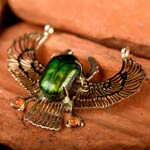
Ankh
The Ankh is a symbolic representation of both Physical and Eternal life. It is known as the original cross, which is a powerful symbol that was first created in Ancient Egypt. Ankh is typically associated with material things such as water, air, sun, as well as with the Gods, who are frequently pictured carrying an Ankh.
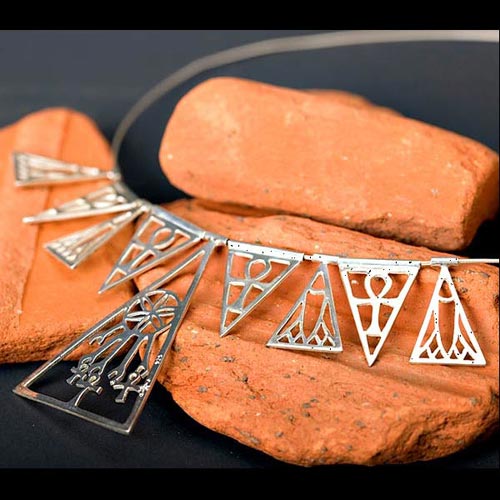
Heart
In Egyptian history, the heart replaced the heart which was removed during mummification. Sometimes assimilated to the Bennu, “Soul of Râ”, it brings the protection of both Osiris and Râ.
Other Egyptian talismans Buckle or Knot of Isis, Djed, Ba, Two Fingers and Udjat or Eye of Horus.
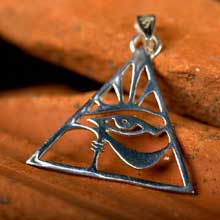
Christian Talismans
The cross: The cross of Christianity was a symbol of the faith. It was previously considered a pagan symbol, with several early church fathers objecting to its use. The cross represents Christ’s victory over death and sin, since it is believed that through His death he conquered death itself.
Fish: The fish’s first known use as a Christian religious symbol was sometime within the first three centuries AD. Christians began using the Greek word for “fish” as an acronym for “Jesus Christ God’s Son, Savior”. Followers of Christianity were called Pisciculi; the root of this Latin word is “fish”.
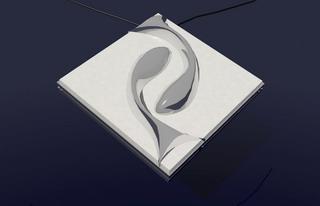
Jewish and Kabbalah Talismans
Star of David: The name David in ancient Hebrew (during the time of King David) is made up of three letters “Dalet”, “Vav” and “Dalet”. The letter Dalet in ancient Hebrew is actually a triangle. King David used the six pointed star as his signature (the two triangles of his name). The middle letter “Vav” means six – The six pointed star. The six-points symbolize that God rules over the universe and protects us from all six directions: North, South, East, West, Up and Down. King David used this symbol in the battlefield on his shield as an omen from God.
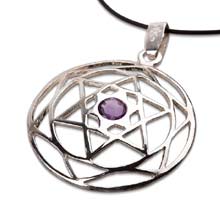
Hamsa: The Hamsa is known as the hand of Miriam or Hamesh hand. The Hamsa serves as an ancient talismanic way of averting the evil eye and providing a “protecting hand” or “Hand of God”. The Hamsa often appears in stylized form, as a hand with three fingers raised, and sometimes with two thumbs arranged symmetrically.
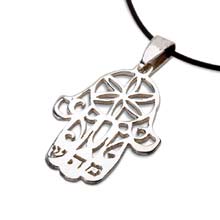
Five metals ring: According to the ancient kabalistic text, the secret of the five metals ring success is that at the specific time of the creation of the ring with these five metals, Jupiter’s influence is summoned forth. Jupiter is the star of development and expansion, and success is at it’s strongest at the specific time of the ring’s creation. The layer on the top of the five metals ring is pure gold. Below it there is a layer of lead and tin, and the last layer is copper, while the ring itself is made out of silver.
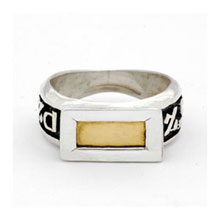
Tree of life: The Tree of Life is one of the most familiar of the Sacred Geometry Symbols. The structure of the Tree of Life is connected to the sacred teachings of the Jewish Kabbalah. The Tree of Life is explained in Sefer Yetzira (“Book of Creation”). The book explains the creation as a process involving the 10 divine numbers (sefirot) of God the Creator and the 22 letters of the Hebrew alphabet. The 10 sefirot together with the 22 letters constitute the “32 paths of secret wisdom”.
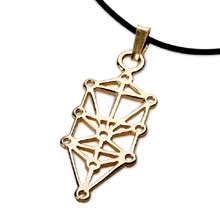
Buddhist Talismans
Buddha: Buddha images provide a reassuring reminder of the basic tenets of Buddhist religion. Just as Buddhist religion is practiced in many different ways, the Buddhist image also serves a wide variety of ritual purposes and has different meanings for different people. Buddha can be invested with a huge amount of information, meaning and implication; they evolve and they are given life. The Buddha image cast in the human form gives it a value presented as calm, still and serene.

Mandalas: The Tibetans create their beautiful Mandalas from colored sand and if you’ll take a metal plate and cover it with sand and make it vibrate with different sounds, you will be able to see different structures that are formed in the sand, that are very similar to the sand Mandalas. In the end, after a few weeks when the Mandalas is finished, they simply wipe the sand off Mandalas to show the non-attachment to the illusion of the external, and also to show the constant change and the process of life and death that takes place in the external world of illusion.
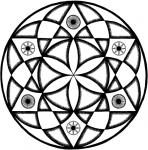
OM: Om (?) is the most sacred syllable in Hinduism, first coming to light in the Vedic Tradition. The syllable is sometimes referred to as the “Udgitha” or “pranava mantra”. The symbol of Om contains three curves, one semicircle and a dot. The large lower curve symbolizes the waking state; the upper curve denotes deep sleep (or the unconscious) state, and the lower curve (which lies between deep sleep and the waking state) signifies the dream state.
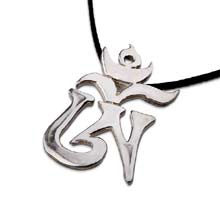
Tibetan Knot: The Tibetan knot (Srivatsa or the endless knot) is one of the eight symbols of the Tibetan Buddhism. The Tibetan knot can stand for karmic consequences: pull here, something happens over there. It is an apt symbol for the Vajrayana methods: Often when we tug at one part of a knot while trying to loosen it, another part becomes tighter. You have to work with the knot to enable it to come undone. In its endless configuration, it evokes the cyclic nature of rebirth and also calls karmic connections to mind.
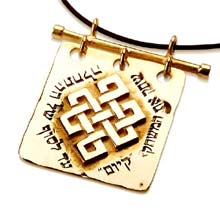
David related work – Talismans jewelry
Article source – Talismans
Written by David Weitzman – Ka Gold Jewelry artist
Images from Ka Gold Jewelry
——————————————————————————————————–
I look forward to your thoughts and comments!
Be sure to Subscribe to this blog either by RSS or Email via the forms on the top right column of the page.
Like this:
Like Loading...













